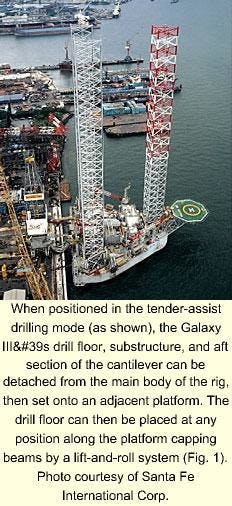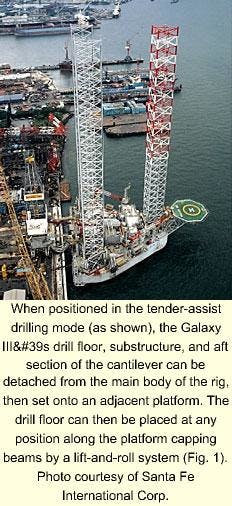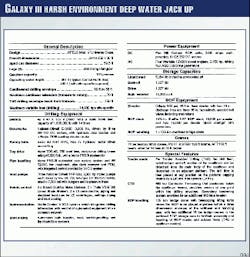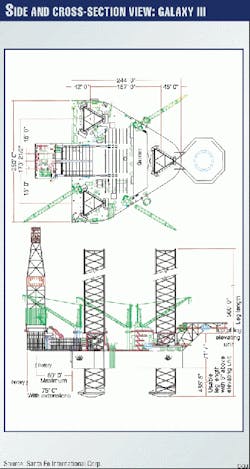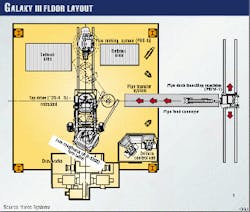The Galaxy III, a heavy-duty-harsh environment jack up, will soon take advantage of advanced pipe-handling technologies and a tender-assist drilling mode as it begins a 3-year contract for BP Amoco plc in the Lomond field of the North Sea.
The jack up departed Keppel's FELS Singapore shipyard Sept. 29 and was expected to arrive on location late November.
Purpose built for Santa Fe International Corp., Dallas, the Keppel FELS Mod VI Universe class vessel was completed in less than 24 months at a total cost of $179 million. Santa Fe says the vessel was completed on time and within 3% of budget (Fig. 1).
The rig, with overall dimensions of 244 x 250 x 36 ft (Fig. 2), can operate in water depths up to 361 ft in the Central North Sea, and up to 400 ft elsewhere (Fig. 3).
Advanced pipe handling
The jack up, which contains advanced pipe-handling equipment developed by Varco Systems (Fig. 4), will be able to perform many operations out of the critical path.
For example, the pipe racking system (PRS-3i), consisting of an upper lifting arm and a lower tailing arm, will allow drillers to build stands of drill pipe in the mousehole while drilling ahead. Additionally, the pipe-deck conveyor and the pipe-deck machine will automate the process of bringing drill pipe in from the pipe deck area to the drill floor.
The pipe-building procedures work as follows:
- Pipe-deck machine picks up a single joint of pipe, moves it over to the pipe transfer conveyor, then places it on the conveyor.
- The conveyor brings the joint up to the drill floor, stopping at a predetermined point where it is then picked up by the elevator attached to the upper lifting arm of the pipe racking system.
- The pipe-racking system hoists the joint to a vertical position as a clutching arm slowly tail ends the joint towards the mousehole.
- The joint is then lowered into the mousehole, completing the first step of the stand building process.
- Steps 1-4 repeat for the second joint. This time, however, the iron roughneck (AR 3200C) is used to make up the box and pin ends of the first and second joints.
- Steps 1-5 repeat, making up the third joint and finishing the stand building process.
- The pipe-racking system then lifts the stand out of the mousehole and racks it back in the derrick.
- Steps 1-7 repeat until the entire drillstring is set back in the derrick.
Meanwhile, drilling operations can proceed at the well center.
To make a connection, the operator drills the stand down with the top drive (TDS 4S). Next, the pipe-racking system proceeds to the finger board, brings the stand to well center, and stabs it into the drillstring. Then the iron roughneck makes up the connection, and the drilling operations proceed forward.
